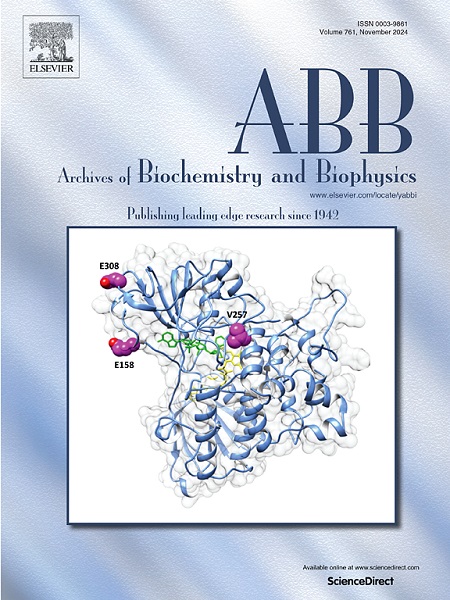Structure and dynamics of Proteus vulgaris tryptophan indole-lyase complexes with l-ethionine and l-alanine
IF 3.8
3区 生物学
Q2 BIOCHEMISTRY & MOLECULAR BIOLOGY
引用次数: 0
Abstract
Tryptophan indole-lyase (TIL; [E.C. 4.1.99.1]) is a pyridoxal-5′-phosphate (PLP) dependent enzyme that catalyzes the reversible β-elimination of indole from l-tryptophan. l-Alanine and l-ethionine are TIL competitive inhibitors that form stable quinonoid complexes with λmax ∼508 nm. We have now determined the X-ray crystal structure of the tetrameric TIL complexes with l-alanine and l-ethionine, with either K+ or Na+ in the cation binding site. For the K+-form, the structures show a mixture of external aldimine and quinonoid complexes, with both open and closed active site conformations. However, the Na+-form exhibits noncovalent and external aldimine complexes in only open active site conformations. Stopped-flow kinetics of l-ethionine binding show that the Na+-form of TIL reacts much more slowly than the K+-form. The l-alanine and l-ethionine complexes of TIL are affected by hydrostatic pressure, suggesting that solvation contributes to the reaction. As pressure increases, the peak at 508 nm decreases, and a new peak at 344 nm appears. These changes are reversible when pressure is released. The 344 nm species could be either a gem-diamine or an enolimine tautomer of the external aldimine. We measured the fluorescence spectrum of the complex under pressure to differentiate these structures. When excited at either 290 or 325 nm, the complex emits at 400 nm, establishing that it is a gem-diamine complex. This peak does not form when the Na+-form of TIL complexed with l-ethionine is subjected to high pressure. Pressure jumps for the TIL-K+-l-ethionine complex measured at 508 nm result in pressure dependent relaxation rate constants. The relaxations show a large activation volume in the direction of quinonoid intermediate formation, suggesting that it is coupled with a conformational change. These results provide new insights into the dynamics of ligand binding to TIL.

Proteus vulgaris色氨酸吲哚裂解酶与l-蛋氨酸和l-丙氨酸复合物的结构和动力学
色氨酸吲哚裂解酶;[。4.1.99.1])是一种依赖于吡哆醛-5 ' -磷酸(PLP)的酶,它催化l-色氨酸中吲哚的可逆β消除。l-丙氨酸和l-乙氨酸是TIL竞争抑制剂,形成稳定的醌类络合物,波长为λmax ~ 508 nm。我们现在已经确定了l-丙氨酸和l-乙氨酸四聚体TIL配合物的x射线晶体结构,阳离子结合位点有K+或Na+。对于K+形式,结构表现为外部醛胺和类醌配合物的混合物,具有开放和封闭的活性位点构象。然而,Na+形式仅在开放活性位点构象中表现出非共价和外醛胺配合物。l-乙硫氨酸结合的停流动力学表明,Na+形式的TIL反应速度比K+形式慢得多。l-丙氨酸和l-乙氨酸配合物受到静水压力的影响,表明溶剂化有助于反应。随着压力的增加,508 nm处的峰减小,344 nm处出现新的峰。当压力释放时,这些变化是可逆的。344 nm的物质既可以是宝石二胺,也可以是外醛胺的烯胺互变异构体。我们在压力下测量了络合物的荧光光谱,以区分这些结构。当在290或325 nm处激发时,该配合物在400 nm处发射,这表明它是一种宝石二胺配合物。当Na+形式的TIL与l-乙硫氨酸络合在高压下时,不会形成这个峰。在508 nm处测量的TIL-K+-l-乙氨酸络合物的压力跳变导致压力依赖的弛豫速率常数。弛豫在类醌中间形成的方向上显示出较大的激活体积,表明它与构象变化相耦合。这些结果为配体与TIL结合的动力学提供了新的见解。
本文章由计算机程序翻译,如有差异,请以英文原文为准。
求助全文
约1分钟内获得全文
求助全文
来源期刊

Archives of biochemistry and biophysics
生物-生化与分子生物学
CiteScore
7.40
自引率
0.00%
发文量
245
审稿时长
26 days
期刊介绍:
Archives of Biochemistry and Biophysics publishes quality original articles and reviews in the developing areas of biochemistry and biophysics.
Research Areas Include:
• Enzyme and protein structure, function, regulation. Folding, turnover, and post-translational processing
• Biological oxidations, free radical reactions, redox signaling, oxygenases, P450 reactions
• Signal transduction, receptors, membrane transport, intracellular signals. Cellular and integrated metabolism.
 求助内容:
求助内容: 应助结果提醒方式:
应助结果提醒方式:


